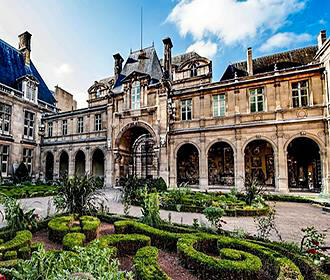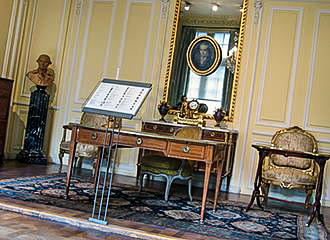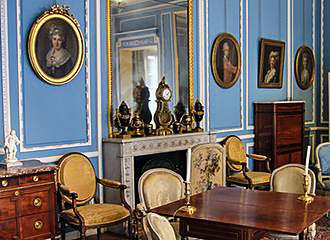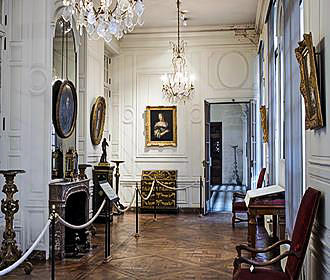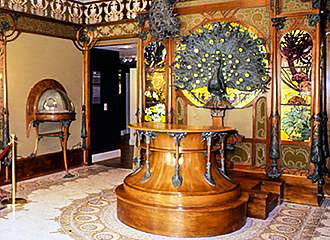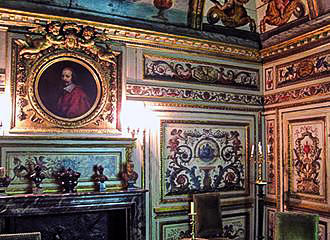Paris Musee Carnavalet museum in France
The Musee Carnavalet is the oldest of the municipal Paris museums and depicts the story and history of Paris from a dugout canoe dating from 4600BC through to the present day, with its collections spread over two elegant mansion houses from the 1500s and 1600s.
About the Paris Musee Carnavalet
As we quickly mentioned, this museum is dedicated to the history of Paris, right through from prehistoric times to the present, although they are not set out in any particular chronological order, as it just happened as the museum expanded.
The Paris Musee Carnavalet is also linked with the Archaeological Crypt at the parvis of Notre Dame Cathedral along with the famous burial place of the catacombes, which are known as the Catacombes de Paris.
And there are so many different things to discover at the Musee Carnavalet museum, that we could never mention everything, yet there are around 100 different rooms to discover that are split between the Hotel Carnavalet and the Hotel Le Peletier de Saint-Fargeau you can enjoy.
But for those of you who love history, let us give you a quick run down on what you can discover in the permanent collections and some of the artefacts on display within this impressive Paris museum.
To start with, located in the Hotel Carnavalet you have the sign galleries that are housed in two galleries, with items like shop keepers signs dating from the 16th century to the 20th century and provide a glimpse at how things have evolved over the centuries. It also includes the Chat Noir sign for the Montmartre cabaret in Paris that was founded back in the 1800s.
Within the same building of the Musee Carnavalet museum, you have the items from the 16th century including paintings and portraits along with a mascaron from the Pont Neuf, which is the oldest bridge in Paris.
Then you have the 17th century galleries, which was the era of Madame de Sevigne and both civil and religious construction is depicted here like The Louvre museum and Les Invalides, which is where you can now discover the Tomb of Napoleon Bonaparte.
You will then be able to discover history of Paris in the 18th century, including a reconstructed reception room from the Hotel d’Uzes and many prestigious pieces of furniture.
A gallery on the first floor links the Hotel Carnavalet building to the Hotel Le Peletier and contains numerous paintings that depict the Belle Epoque era, plus free temporary exhibitions are held here as well.
Then entering the Hotel Peletier de Saint-Fargeau, you will find galleries dedicated to the French Revolution including a scale model of the former Bastille prison at the Place de la Bastille, that was constructed using stone from the building when it was destroyed.
You will then be able to discover the 19th century history of Paris from the French Directory to the second Republic including furniture, paintings and more, following on to other galleries depicting the 19th century again, but this time from the Second Empire to the Third Republic.
So here you can discover more about the French Commune that brought the reign of Napoleon III to a close, paintings that depict the high society as well as the working class, along with many different objects on display including the ornate cradle designed for the son of Empress Eugenie, the Prince Imperial.
Then the Paris Musee Carnavalet entices you to discover more about the 20th century in Paris, with different rooms having been recreated such as the bedroom of writer Marcel Proust along with paintings, portraits a complete ballroom interior and much more.
Yet the most ancient artefacts are to be found in galleries within the Orangery of the Hotel Peletier and these cover the prehistoric times through to the Gallo-Roman times. The majority of items on display have been found during archaeological digs within Paris and it is here you can discover a mammoths molar through to Neolithic dug out canoes dating from 4800BC through to a surgeons instrument case from the 3rd century.
Also, the Musee Carnavalet museum houses the most comprehensive collection on the French Revolution, however, we cannot forget to mention the museum garden including an old doorway that used to be on the Ile de la Cite island and the original version of the Victory Statue that sits on top of the Chatelet Column.
There is also the Graphic Arts Rooms housed within the Hotel Peletier, which has an impressive print collection of engravings, drawings and photographs, yet this particular section is only available by prior appointment.
Access to Paris Musee Carnavalet
Now the Paris Musee Carnavalet is open on a Tuesday to Sunday from 10am through to 6pm, however, it is always closed on a Monday and on all national French holidays, but we would like to point out that the ticket office closes one hour before the museum closes.
But we would like to point out that the Museum Garden is only open at the same time as the museum between the months of April and October, and the monumental gate, which is normally closed, is then open for people who wish to sit down and relax in this little haven of tranquillity away from the hustle and bustle of the city.
You may be pleased to know that the permanent collections are completely free to visit and the museum is accessible to the disabled, however, there is a charge for temporary exhibitions and this does vary, but you can find out more information on either of these points by telephoning +33 (0) 1 44 59 58 58.
Yet when it comes to the Print collection that includes engravings, drawings and photographs located at 29 Rue de Sevigne, this is only open on a Tuesday through to a Friday from 2pm to 5pm by prior arrangement, and appointments can be made by telephoning +33 (0) 1 44 59 58 67.
Workshops, lecture visits and slide lectures are also available, but these are a charge from around €5 to €10 per person, but these do have to be booked.
And located in the 3rd Arrondissement, getting to the Paris Musee Carnavalet museum is very straightforward with the Paris public transport, as there are actually three Metro stations close by called the Saint-Paul stop serving line 1, Chemin Vert stop serving line 8 or Breguet Sabin stop serving line 5. Alternatively, you could utilise the Paris buses numbered 29, 69, 76 and 96.
